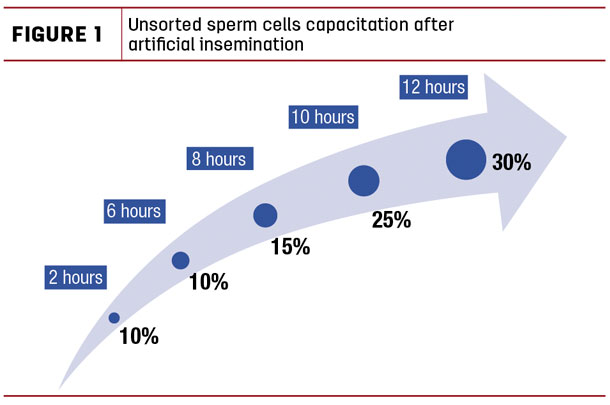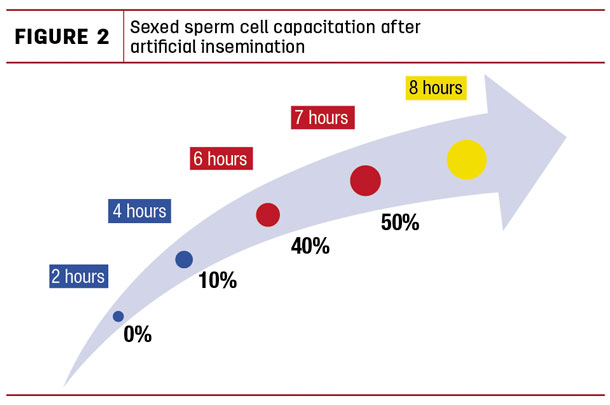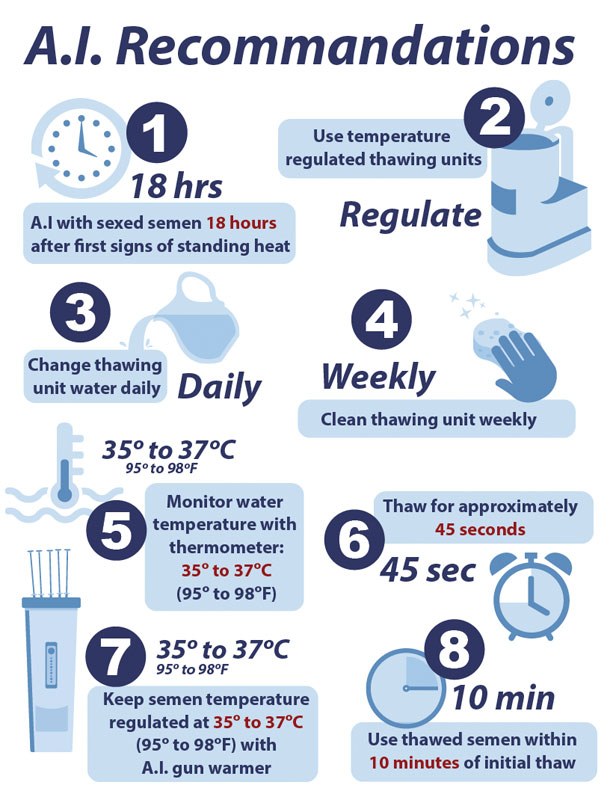Bovine genetics is undoubtedly one of the areas that has benefited from this scientific wave with the advent of genomics, assisted reproduction techniques and sexed semen. The latter is possibly the one that has seen the most significant progress in terms of quality and availability of the product.
While it was expensive, used with bulls of low genetic value and relatively low fertility just a decade ago, the most advanced sexed semen technology available on the market is now affordable, even with the best bulls available, and breeders obtain results similar to those observed with conventional semen.
As with any modern technology, there are some parameters to consider maximizing results. Here are some of the sexed semen characteristics that will affect your on-farm conception rates.
Sexed sperm cell more mature
Following the bull’s collection, the ejaculate that will be sexed will undertake a series of additional procedures before being frozen, compared to conventional semen.
The process of sorting female sperm using a fluorescence technique of their DNA content, which is 3.8 percent higher than that of their male sperm cell counterpart, causes a physiological change in the cells. In fact, when collected, the spermatozoa are morphologically mature, but to be competent at fertilizing the oocyte, they must undergo physiological changes in the female reproductive tract.
This is called capacitation. We observed significant differences following the steps of the sorting process on the biochemistry of the spermatozoa. Specifically, the sperm capacitation following the sorting process will be more advanced at the time of the act of insemination than the physiological stage in which the non-sorted sperm shows.
For example, at seven hours after insemination, 50 percent of sexed sperm will be mature to fertilize the oocyte, compared to less than 15 percent for non-sorted sperm (see Figures 1 and 2).


These figures highlight the existence of micropopulations (spermatozoa groups) in one dose of semen, each group having fertilization skills at different times. In general, sexed semen is more rapid in capacity or, in other words, is more rapidly ready to fertilize in the oviduct and demonstrates more homogeneity in this regard during quality control.
Delay insemination with sexed semen
The A.I. protocol traditionally used for conventional semen must be adapted for the use of sexed semen. Taking into account this physiological differentiation between sexed and conventional semen, it is recommended to delay insemination for about six hours when sexed semen is used. Thus, sexed semen performs better when used 18 hours after estrus (peak heat), compared to about 12 hours for conventional semen.
With sexed semen, insemination should be done closer to ovulation time regardless of the protocol in place (natural or synchronized insemination, flush, etc.). This time to insemination increases the conception rate of the new generation of sexed semen to a level similar to that of conventional semen.
Additional A.I. recommendations with sexed semen
Finally, beyond waiting the additional six hours before breeding, proper care of thawing equipment and semen handling must be observed to achieve maximum conception rates with the use of sexed semen. See the series of important recommendations to be followed below.

Optimize the use of available uteruses
Easily accessible sexed semen has become the tool of choice for controlling the effectiveness of a breeding program. By planning the best use of each available uterus and gestation to produce either a high-genetic-value heifer (from an elite female and male) or a beef male calf (from the male sex semen of a beef bull selected for dairy purposes for ease of calving, high fertility and high average daily gain), you will maximize the use of your farm’s animal resources for increased genetic gain and profits of calves sold at auction. ![]()
Jean-François Thouny is the Ontario sales director with STgenetics Canada.

-
Dany Plourde
- Genetic Program Manager
- STgenetics Canada
- Email Dany Plourde







